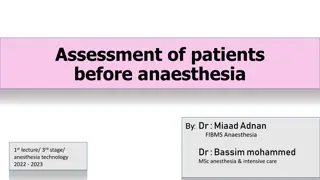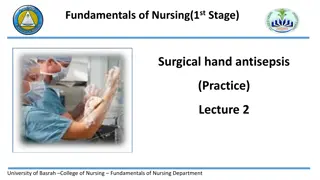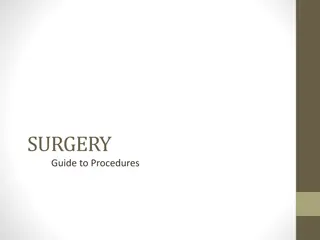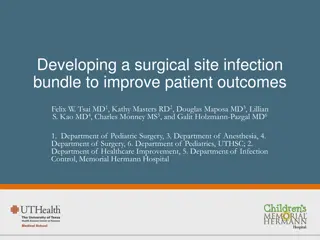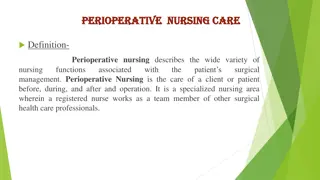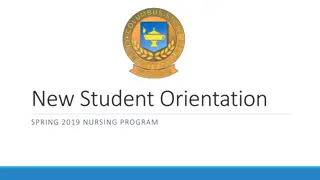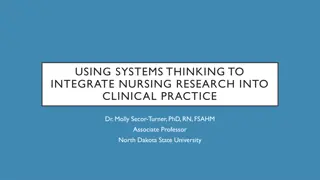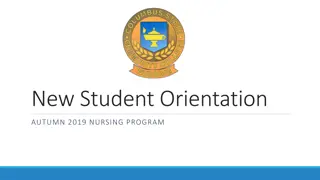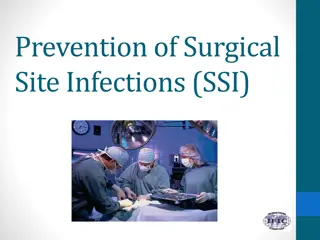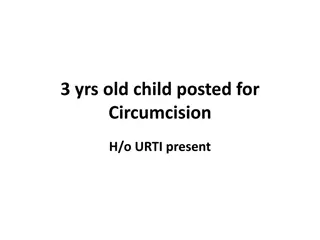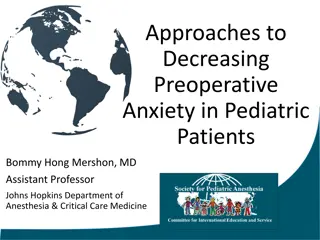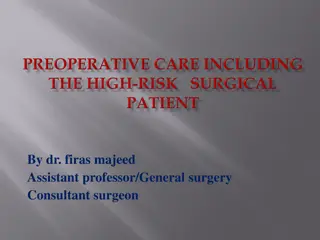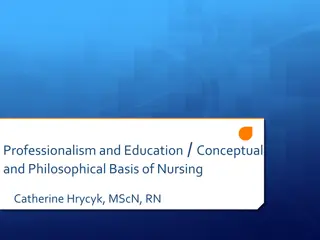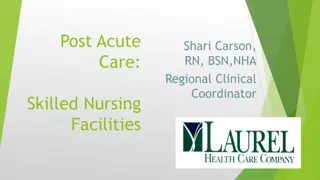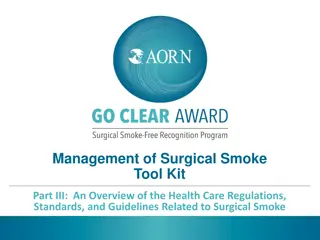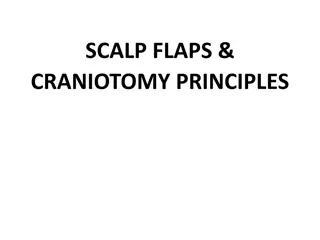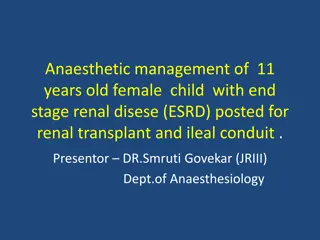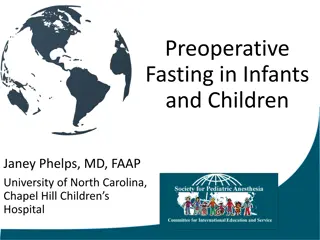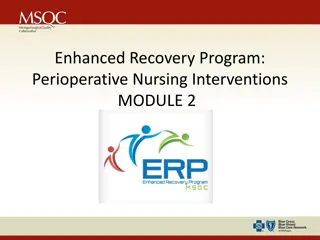Evidence-Based Insights on Preoperative Patient Education in Surgical Nursing
Preoperative patient education plays a crucial role in surgical nursing, aiming to reduce anxiety, empower patients, and enhance recovery outcomes. Limited systematic evidence exists on its specific impact, influenced by patient engagement, knowledge levels, nurse expertise, and empowerment factors. Studies have shown improved clinical outcomes, patient satisfaction, and faster recovery with structured preoperative education programs.
- Preoperative education
- Surgical nursing
- Evidence-based practice
- Patient empowerment
- Surgical outcomes
Download Presentation

Please find below an Image/Link to download the presentation.
The content on the website is provided AS IS for your information and personal use only. It may not be sold, licensed, or shared on other websites without obtaining consent from the author. Download presentation by click this link. If you encounter any issues during the download, it is possible that the publisher has removed the file from their server.
E N D
Presentation Transcript
Preoperative Education What works? What doesn t? What is the evidence? Shirley Lockie
ABOUT ME Diploma of Practice Management 15 years in the OR PNSA MClin Sci specializing OBESITY Executive member of OSSANZ PNAQ (ACORN QLD ) education AANSA Secretary Fully credentialled PNSA at 4 hospitals
Perioperative Nurse Surgical Assistant Initial patient assessment, physical exam, medical history and coordination of pre surgery tests in collaboration with the surgeon. Patient education during the pre-surgery, intra operative and post-surgery phases of the patients episode of care.
PERIOPERATIVE SERVICES From a perioperative point of view - what if......we were able to identify and measure key points before bariatric surgery, to provide an enhanced recovery and ultimately influence long term results?
Why do we educate ? Better informed patient ASSESS TEACH EVALUATE Knowledge and confidence to recover control over their weight loss surgery
Preoperative Education Hayward 1975: pts given preop information required less analgesia and had faster recovery. Lookinland and Pool 1998 demonstrated that a structured preoperative education program improved clinical outcomes, gave better patient satisfaction and faster recovery, as compared to unstructured post op education. Goldstein and Hadidi 2010: Demonstrated that pt who attended a bariatric preoperative education class had higher levels of knowledge and post operative satisfaction.
Practice Audit In my practice we discovered 90% of our patients had unidentified comorbidities:- Obstructive Sleep Apnoea (OSA) Diabetes Hypertension Hiatus Hernia/GERD
What is Preoperative education? Preoperative patient education is a common and important intervention in surgical nursing, yet there is very limited systematic evidence on its precise role. It is subject to many factors eg ,Pt Engagement/level of understanding,pt knowledge,perioperative Nurse knowledge, Empowerment- Control -Self Belief -Coping Strategies The purpose is to reduce anxiety,provide empowerment,ownership and patient control
Hospital Preoperative Clinics Physical health questionnaire only: few days before or on the day of surgery. Research shows often the information gathered is inconsequential,often not passed to medical staff, not factually correct (pt perception I don t snore )
HOW? LEAFLETS DOCUMENTS IPAD PROGRAMS APPS VIDEOS (pts may re-watch several times )
WHEN and WHERE? SURGEON S OFFICE STRUCTURED PROGRAM EDUCATION SHOULD BE EVERYWHERE WITH PERIOPERATIVE SUPPORT DISCUSSIONS AND TIME TO TEACH A discrepancy between nurses' perceptions and practice in relation to the provision of preoperative information was found. Limited teaching aids, tight operation schedules and language barriers affected the delivery of preoperative information to ambulatory surgical patients.
WHAT IS ALREADY HAPPENING YOUTUBE FORUMS GOOGLE/BLOGS FACEBOOK/WEB CHAT-SUPPORT GROUPS COSMOPOLITAN/magazines/advertising Media -Talking Point-BIG MEDICINE
Trust me, I am a website! Nichols and Oermann 2005: evaluated 40 websites 75% had evidence of commercial promotion 62.5% biased Only 37.5% recently updated
What are we measuring ? Measuring long term results ? Weight loss ,Quality of Life ? Resolve of comorbidities?
CeQOL Carolina Equation for Quality of Life Focus on Inguinal Hernia Repair -Based on mesh repair patient outcomes had been significantly improved Quality of Life measurements focussed on pain, mobility and % chance of discomfort 1 year after surgery Realistic expectations are explained via data collection and via the algorithm. The patient can see the likely results taking control of their potential outcome.
CeDAR Carolinas Equation for Determining Associated Risks Diagnosis and stabilization of Diabetes,Reducing BMI and ceasing smoking Reduces the complication rate 68%-23% Cost economics in some USA healthfunds are using this tool to charge patients less with specific surgeons and pathways which advocate preoptimization
Blackstone and Cortes SORD 2010 age body mass index history of deep venous thrombosis or pulmonary embolism severity of sleep apnea diabetes hypertension mobility cardiac status psychological classification.
Readmission Variables Nausea, vomiting, and dehydration (26%), Abdominal pain (20%) ? Constipation? Wound issues (8%) Respiratory reduced readmission rates from 8.5% to 1.7% Preoperative optimisation of Comorbities, Surgical Complication Unstable Diabetes/Hypertension Hypercapnoea Pulmonary Embolism-DVT
Establishing pathways Experience Literature Trial and error pathways Development of pathways Analysing complications and readmissions
Introducing a dedicated bariatric program During an episode of surgical care, adverse outcomes and therefore patient safety are primarily determined by the quality of the systems of care National Surgical Quality Improvement Program Surgeons qualifications contribute to the system However there is much importance on communication, coordination and teamwork in achieving quality surgical care.
Dumon et al SORD 2011 Studied outcome and quality indicators over a 6 yr period. 1886 Gastric bypass procedures, involving 2 surgeons. Team approach: surgeons, bariatric coordinator, dedicated anaesthetists, dietician, phyios, mental health specialists and bariatric nurses. Establish clinical pathways including perioperative workup and education.
Preoperative work up Initial Consult-Office visit with Surgeon Evaluation Blood work,HBA1C TSH FBC Complete Metabolic Panel Pulmonary Function Tests ECG Chest Radiograph (Chest X Ray ) Upper GI Study Sleep study
Perioperative Pathways DVT prophylaxis Incentive Spirometry Hydration program Restricted post operative diet Thorough post operative visit and follow up schedule
Ancillary Evaluation Endocrinology consult if history of disease Pulmonary consult if history of disease Cardiology if hypertensive BMI >50 age>50 Diabetic or hypertensive
Complications GI bleeding Respiratory Arrest Anastomotic leakage Cardiac Arrest Wound Infection PE Wound Dehiscence DVT Bowel Obstruction UTI Dehydration
Results Reduction overall complication rate 18.6% to 4.8% Reduction in overall length of stay: 6.7 days to 3.2 days Reduction in 30 day readmission rates 15.7% to 8.1%
Evidence Underlying systems and processes Direct effect of bariatric programs Direct effect on patient care Surgeons experience and volume
Implementing Perioperative Pathways Team communication Time to provide the teaching skills and literature Reinforcement of the processes via eg support group
Related Facts! 60% pts with hypertension, BMI>35 will have OSA. Undiagnosed OSA can lead to extubation issues-unplanned ICU admission. Risks of respiratory complications, haematoma, infection, return to theatre, poor post operative coping skills.
Multidisciplinary Approach Multidisciplinary teams work because they:- All talk the same language information from a specific expert opinion eg psychology,dietitian Continually reinforce the need to know and how to make the operation work on a one to one basis and Patient to team relationship Individual programs per patient analysing pt specifics eg blood deficiencies,Rx and monitoring pt outcomes
What Doesnt Work (as well) Last Minute Dot Com Drive Through What is the long term result
Preoperatively At the Cleveland Clinic Bariatric and Metabolic Institute, we believe that optimal teaching about readmission prevention should be completed 1 2 weeks before admission. Karen Schulz
Cleveland Clinic Has a dedicated nurse who calls patients 1 2 days after discharge to review questions regarding potential complications. Patients are educated preoperatively regarding the 24-hour on call phone service. Patients are also informed about a hydration clinic that is available for individuals who fall behind in their fluid intake. After surgery, individuals are encouraged to visit their primary care provider 1 2 weeks after surgery to assist in monitoring of blood pressure, blood sugar, and any other medical co- morbidities.
Professional Responsibility As a perioperative Nurse I see the benefits of patients on the program in my practice We have a duty of care to at least try to provide the preoperative service knowing that this DOES influence long term outcomes To initiate proactive treatment for best long term outcomes
REFERENCES Nurses' perceptions of preoperative teaching for ambulatory surgical patients. J Adv Nurs. 2008 Sep;63(6):619-25. doi: 10.1111/j.1365-2648.2008.04744.x. B Todd Heniford, MD, FACS, et al. Comparison of Generic Versus Specific Quality-of-Life Scales for Mesh Hernia Repairs. J Am Coll Surg 2008;206:638 644. CeQOL ceqol@carolinashealthcare.org CeDAR. Budak et al. Patient education: Effective methods of content delivery. Bariatric Nursing and Surgical Patient Care Vol 3 Number 4 2008 Hunt et al. Safe Passage A Team Approach to Positive Outcomes for Bariatric Patients MedSurg Nursing Vol 3 Number 4 2008 Olaithe M; Bucks RS. Executive dysfunction in OSA before and after treatment: a meta-analysis. SLEEP 2013;36(9):1297-1305. Chaar et al 2010. Does patient compliance with preoperative bariatric office visits affect post operative excess weight loss. SORD 7 (2011) 743-748 Moon RC et al. Treatment of Weight Regain Following Roux-en-Y Gastric bypass,Revision of pouch,Creation of new Gastrojejunostomy and placement of Proximal pericardial patch. Obesity Surgery Journal Vol 24 No 6 2014
References Blackstone RP, Cortes MC. Metabolic acuity score: effect on major complications after bariatric surgery. SORD 2010;6(3):267 73. Blackstone RP, Cortes MC, Messer LB, et al. Psychological classification as a communication and management tool in obese patients undergoing bariatric surgery. SORD 2010;6(3):274 81. Kellogg TA, Swan T, Leslie DA, et al. Patterns of readmission and reoperation within 90 days after Roux-en-Y gastric bypass. SORD 2009;5(4):416 23. Cottingham K, McCarty T, Arnold D, et al. Preoperative vs postoperative administration of low molecular weight heparin for laparoscopic gastric bypass. Oral presentation, 21st Annual Meeting of the American Society for Bariatric Surgery; San Diego, California; 2004. Hyatt et al. The effects of sleeve gastectomy on gastro-esophageal reflux and gastro-esophageal motility Expert Rev. Gastroenterol. Hepatol. 8(4), 445 452 (2014) Karen Schulz, M.S.N., C.N.S., C.B.N. Decreasing bariatric surgery: Readmissions with preoperative education. SORD 10 (2010): 387-388 Dumon KR et al: Implementation of designated bariatric surgery program leads to improved clinical outcomes. SORD 7 (2011): 271-276




